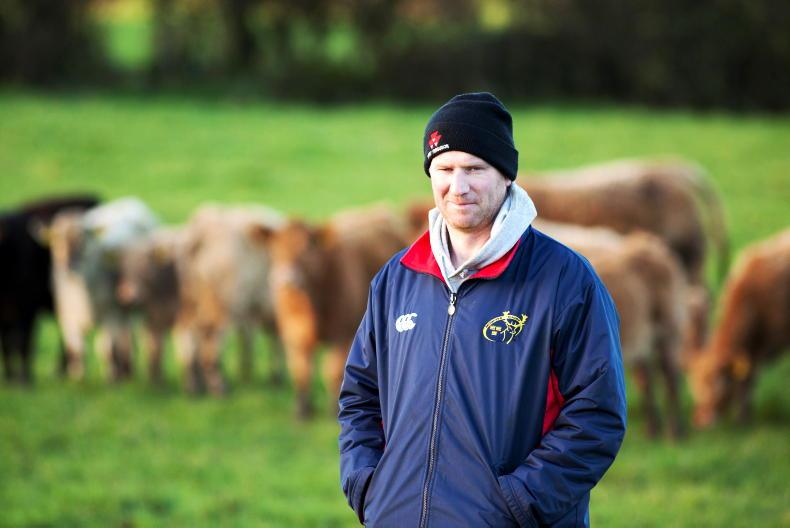Grazing conditions are continuing to prove difficult for many farmers as wind and rain batter the country.
More than an inch of rain fell in a single 24-hour period in some parts of the northwest, forcing many farmers to re-house livestock.
The wet spell has led to increased pressure on fodder supplies, with some farmers having to purchase fodder. Sheep farmers have also been put under pressure for housing with many having to hold ewes and lambs indoors longer than usual.
Delayed fertiliser applications will result in late first cut silage and grass shortages on grazing ground in some parts of the country.
The situation could be a lot worse were it not for the dry month of February, when many farmers took the opportunity to empty slurry tanks.
This has aided grass growth but the ground conditions mean that stock can’t get out to graze it.
Meal bills are also mounting, with meal bins on farms being filled again to feed stock that would normally be outdoors at this stage.
Speaking to the Irish Farmers Journal, Teagasc beef specialist Aidan Murray said : “There are still a lot of cows and calves indoors on suckler farms and that’s presenting challenges like scours and E coli mastitis.
Farmers in the north of the country are lucky to have silage reserves but down south silage supplies are coming under more pressure.”
He added: “Farmers need to consider now about going out with 80 units N/acre to get a cut in late May/June and aim for a good second cut later in the year.”
Seán O’Riordan, Kiskeam, Cork – Dairy
“We’re fed up with it now. We’re indoors fully since Monday night. I just pulled the plug on it again. We went at [grazing] in February and I think we had 10-12 days out day and night with 30% grazed by 6 March but they’ve been more or less in since then. The ground conditions here are just not good enough. Milk volumes are back compared to last year by 2litres/cow, because we’re feeding silage rather than grass. We’re ok for stocks of silage. The plan is to just go day to day and monitor things.”
Paudie Byrne, Glenmalure, Wicklow – Sheep
“You’d always get a bit of storm in early April but you wouldn’t be expecting this. I’ve been lambing [outdoors] the last week or so. Normally if you get them in and get them a bit of shelter and suck, they’d be ok. The big thing is being on top of them straight away and make sure they get a suck. I have to have them close to the yard, especially at night.

Seán Hayes, Lissduff, Tulla, Co Clare
Seán Hayes, Tulla, Clare - Sucklers
“The cattle were let out towards the end of January but had to be brought back in due to the ground conditions. Recently I have let out all the remaining stock that were housed. Even though I am fortunate enough to have silage in the yard I’ll be leaving the stock at grass from now on. Cows were coming into heat in the shed and I was going to get animals hurt so I had to go. Ground conditions aren’t too bad. I have the cattle on the driest part of the farm. I’m making sure to keep cattle moved on even though they are not cleaning out the paddocks.”

Niall Patterson
Niall Patterson, Carrigallen, Leitrim - Sucklers and sheep
“Currently the cattle are still housed while the sheep are at grass. Twelve acres of the farm have received silage fertiliser. I have enough silage to get as far as June but hopeful we won’t need it. It’s been a long hard spring with poor grass covers and poor regrowth. Grazed ground received slurry during the dry spell at the end of February.
“With the heavy type of ground that we farm it will need 10 days of good weather to dry the fields from the conditions experienced in March and April.”

Tommy Holmes
Tommy Holmes, Ballina, Mayo - Store to finish
“Only a small portion of the lighter heifers are at grass currently on high ground. I am fortunate to have a good reserve of silage this year. Silage swards have been spread with fertiliser and have good covers. Grazed ground received an application of protected urea. The dry spell in February allowed us to get the slurry spread without much damage in the fields. I see the weather starting to impact the mart trade with grass cattle a lot easier bought this week.”

Tim O'Sullivan
Tim O’Sullivan, Sneem, Kerry
“Currently we are under extreme pressure as we are experiencing the worst of the country’s weather conditions. I have no cattle currently grazing and I am using up 2021 silage reserves. The fertiliser has been spread in recent days but it was followed by large volumes of rain which we weren’t expecting.
“We got slurry spread in February to relieve the pressure on the tanks. There is poor grass growth currently. April is an important month to get cattle turned out but it seems it won’t be happening in 2023 down here.”
Grazing conditions are continuing to prove difficult for many farmers as wind and rain batter the country.
More than an inch of rain fell in a single 24-hour period in some parts of the northwest, forcing many farmers to re-house livestock.
The wet spell has led to increased pressure on fodder supplies, with some farmers having to purchase fodder. Sheep farmers have also been put under pressure for housing with many having to hold ewes and lambs indoors longer than usual.
Delayed fertiliser applications will result in late first cut silage and grass shortages on grazing ground in some parts of the country.
The situation could be a lot worse were it not for the dry month of February, when many farmers took the opportunity to empty slurry tanks.
This has aided grass growth but the ground conditions mean that stock can’t get out to graze it.
Meal bills are also mounting, with meal bins on farms being filled again to feed stock that would normally be outdoors at this stage.
Speaking to the Irish Farmers Journal, Teagasc beef specialist Aidan Murray said : “There are still a lot of cows and calves indoors on suckler farms and that’s presenting challenges like scours and E coli mastitis.
Farmers in the north of the country are lucky to have silage reserves but down south silage supplies are coming under more pressure.”
He added: “Farmers need to consider now about going out with 80 units N/acre to get a cut in late May/June and aim for a good second cut later in the year.”
Seán O’Riordan, Kiskeam, Cork – Dairy
“We’re fed up with it now. We’re indoors fully since Monday night. I just pulled the plug on it again. We went at [grazing] in February and I think we had 10-12 days out day and night with 30% grazed by 6 March but they’ve been more or less in since then. The ground conditions here are just not good enough. Milk volumes are back compared to last year by 2litres/cow, because we’re feeding silage rather than grass. We’re ok for stocks of silage. The plan is to just go day to day and monitor things.”
Paudie Byrne, Glenmalure, Wicklow – Sheep
“You’d always get a bit of storm in early April but you wouldn’t be expecting this. I’ve been lambing [outdoors] the last week or so. Normally if you get them in and get them a bit of shelter and suck, they’d be ok. The big thing is being on top of them straight away and make sure they get a suck. I have to have them close to the yard, especially at night.

Seán Hayes, Lissduff, Tulla, Co Clare
Seán Hayes, Tulla, Clare - Sucklers
“The cattle were let out towards the end of January but had to be brought back in due to the ground conditions. Recently I have let out all the remaining stock that were housed. Even though I am fortunate enough to have silage in the yard I’ll be leaving the stock at grass from now on. Cows were coming into heat in the shed and I was going to get animals hurt so I had to go. Ground conditions aren’t too bad. I have the cattle on the driest part of the farm. I’m making sure to keep cattle moved on even though they are not cleaning out the paddocks.”

Niall Patterson
Niall Patterson, Carrigallen, Leitrim - Sucklers and sheep
“Currently the cattle are still housed while the sheep are at grass. Twelve acres of the farm have received silage fertiliser. I have enough silage to get as far as June but hopeful we won’t need it. It’s been a long hard spring with poor grass covers and poor regrowth. Grazed ground received slurry during the dry spell at the end of February.
“With the heavy type of ground that we farm it will need 10 days of good weather to dry the fields from the conditions experienced in March and April.”

Tommy Holmes
Tommy Holmes, Ballina, Mayo - Store to finish
“Only a small portion of the lighter heifers are at grass currently on high ground. I am fortunate to have a good reserve of silage this year. Silage swards have been spread with fertiliser and have good covers. Grazed ground received an application of protected urea. The dry spell in February allowed us to get the slurry spread without much damage in the fields. I see the weather starting to impact the mart trade with grass cattle a lot easier bought this week.”

Tim O'Sullivan
Tim O’Sullivan, Sneem, Kerry
“Currently we are under extreme pressure as we are experiencing the worst of the country’s weather conditions. I have no cattle currently grazing and I am using up 2021 silage reserves. The fertiliser has been spread in recent days but it was followed by large volumes of rain which we weren’t expecting.
“We got slurry spread in February to relieve the pressure on the tanks. There is poor grass growth currently. April is an important month to get cattle turned out but it seems it won’t be happening in 2023 down here.”










 This is a subscriber-only article
This is a subscriber-only article










SHARING OPTIONS: